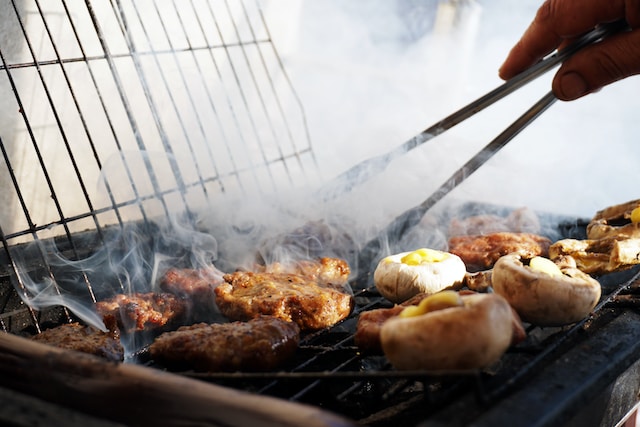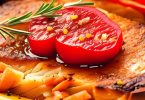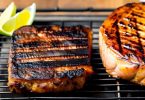Are you curious about the science behind grilling? Have you ever wondered whether the heat transfer method used in grilling is conduction, convection, or radiation? Well, you’re not alone! In this article, we will explore the different heat transfer methods and how they relate to grilling.
Is Grilling Conduction Convection or Radiation
In grilling, the essential concept is heat transfer. The three main methods of heat transfer are conduction, convection, and radiation. Conduction is the transfer of heat through direct contact, while convection occurs when heat is transferred through a fluid or gas.
Radiation, on the other hand, involves heat transfer through electromagnetic waves. Each of these methods of heat transfer plays a role in grilling, and understanding them can help you achieve the perfect cook on your favorite meats and vegetables.
The Three Types of Heat Transfer
Conduction
The primary heat transfer method used in grilling is conduction. This method involves the transfer of heat through a material without any movement of the material itself.
When grilling, the grill grates act as the heat source and transfer heat to the food through direct contact. As a result, the heat flows from the hot grill grates to the cooler food, allowing for even cooking and deliciously charred grill marks.
The type of material the grill grates are made of can affect how well heat is transferred. Stainless steel is a poor conductor of heat, while cast iron is an excellent conductor. Cast iron grates will transfer heat more efficiently to the food.
Convection
Convection is the transfer of heat through a fluid, such as air or water. When you grill, convection occurs as the hot air rises and the cooler air sinks.
This creates a convection current that helps to cook the food evenly. However, the convection currents are not as strong as they are in an oven, so convection is not the primary heat transfer method when grilling.
Radiation
Heat transfer through electromagnetic waves is known as radiation. When you grill, radiation occurs as the heat from the grill grates is emitted as infrared radiation.
This radiation is absorbed by the food, which causes it to cook. However, radiation is not as important in grilling as it is in other cooking methods, such as broiling.
In summary, when you grill, the main heat transfer method is conduction. Convection and radiation also play a role, but to a lesser extent.
The type of material the grill grates are made of can affect how well heat is transferred, and understanding the different types of heat transfer can help you cook your food more evenly and efficiently.
Grilling and Heat Transfer
Grilling is a popular method of outdoor cooking that utilizes heat transfer to cook food. There are three types of heat transfer: conduction, convection, and radiation.
Grilling primarily relies on direct heat transfer, which is the transfer of heat through direct contact between the food and the heat source. However, there are other factors that affect the heat transfer during grilling.
Direct Heat
Direct heat is the most common method of grilling. This method involves placing the food directly on the heat source, such as a gas burner or charcoal. The heat is transferred from the heat source to the food through direct contact.
When using direct heat, it’s important to create a sear on the food to enhance the flavor and texture. Searing is the process of cooking the food at a high temperature to create a crust on the surface.
The Maillard reaction is responsible for the delicious flavor and aroma of grilled food. This chemical reaction occurs between the amino acids and reducing sugars in the food, resulting in the distinctive taste and texture of grilled meat.
The choice of heat source used in grilling can significantly affect the heat transfer process. Charcoal grills primarily produce infrared radiation, which is converted to heat when it strikes the food.
In contrast, gas grills generate mostly convection heat, which can be dissipated easily by air currents and distance. While infrared radiation can penetrate the food more effectively, it is important to consider the type of heat source that best suits your grilling needs.
Indirect Heat
Indirect heat is another method of grilling that involves placing the food away from the heat source, such as on the opposite side of the grill or under a lid. The heat is transferred to the food through convection and radiation.
When cooking larger cuts of meat or foods that require longer cooking times, indirect heat is the preferred method.It allows the food to cook evenly without burning or charring on the outside. The lid of the grill helps to trap the heat and create a convection oven-like environment.
When using indirect heat, it’s important to control the airflow to maintain a consistent temperature. This can be achieved by adjusting the vents or dampers on the grill. The number of burners used on a gas grill can also affect the heat distribution.
Grilling vs Other Cooking Methods
Grilling vs Oven Cooking
When it comes to cooking food, the oven is a popular choice for many people. It is a versatile cooking appliance that can handle a wide range of dishes. However, grilling has its advantages over oven cooking.
Grilling allows you to cook food with direct heat, which can result in a crispier texture and a more flavorful taste. On the other hand, oven cooking uses convection heat, which can lead to a more even cooking process.
Grilling vs Pan Cooking
Pan cooking is another popular cooking method that many people use. It is a convenient way to cook food quickly and easily. However, grilling offers some unique advantages over pan cooking.
Grilling allows you to cook food with high heat, which can result in a charred exterior and a juicy interior. Pan cooking, on the other hand, is limited by the size of the pan and the amount of heat it can generate.
Grilling vs Deep Fry
The cooking technique of deep frying entails immersing food into hot oil.It is a popular way to cook food quickly and create a crispy exterior. However, grilling has its advantages over deep frying.
Grilling allows you to cook food without adding any extra oil, which can result in a healthier meal. Additionally, grilling can help retain the natural flavors of the food, while deep frying can sometimes mask those flavors.
In summary, grilling offers some unique advantages over other cooking methods. It allows you to cook food with direct heat, which can result in a crispy texture and a more flavorful taste.
While other cooking methods, such as oven cooking, pan cooking, and deep frying, have their own benefits, grilling is a great way to cook a wide range of dishes, including vegetables, steak, and fish.
Conclusion
As mentioned earlier in this article, grilling involves various forms of heat transfer. The two main forms of heat transfer in grilling are conduction and convection. Conduction refers to the transfer of heat through direct contact, while convection involves the transfer of heat through the movement of fluids like air or water.
When you cook on a grill, the heat source, whether it be a flame or an electric heating element, heats up the grates. The grates then transfer heat to the food through conduction. The hot air surrounding the food also transfers heat to the food through convection. This is why it is important to keep the lid closed on your grill to allow for proper convection cooking.
Additionally, radiation plays a role in grilling, as the heat source emits electromagnetic energy in the form of infrared radiation. This radiation can penetrate the food and heat it from the inside out. However, radiation is not the primary form of heat transfer in grilling.
It is also important to note that the exhaust system, TEC, and fan of your barbecue play a significant role in regulating the temperature and heat distribution of your grill. Understanding the physics of heat transfer can help you become a better cook on the grill, ensuring that your food is cooked to perfection every time.
Overall, grilling involves a complex interplay of energy and heat transfer. By understanding the science behind grilling, you can become a master of the grill and impress your friends and family with perfectly cooked meals. Happy grilling!







